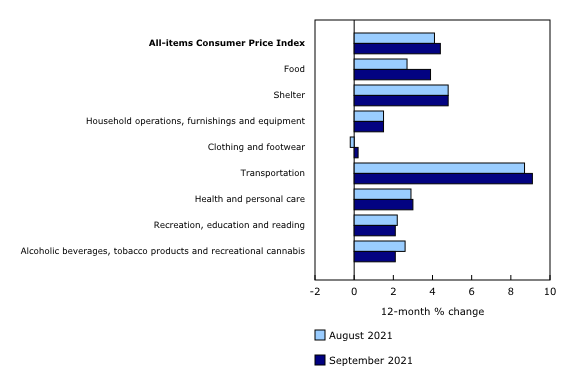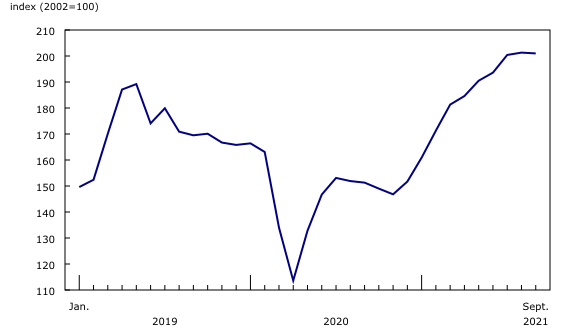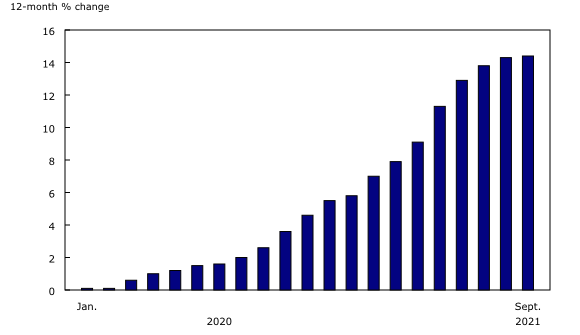Consumer Price Index, September 2021
Archived Content
Information identified as archived is provided for reference, research or recordkeeping purposes. It is not subject to the Government of Canada Web Standards and has not been altered or updated since it was archived. Please "contact us" to request a format other than those available.
Released: 2021-10-20
September 2021
4.4% 
(12-month change)
The Consumer Price Index (CPI) rose 4.4% on a year-over-year basis in September, the fastest pace since February 2003 and up from a 4.1% gain in August. Excluding gasoline, the CPI rose 3.5% year over year in September.
The monthly CPI rose 0.2% in September, the same growth rate as in August. Month-over-month CPI growth has been positive for nine consecutive months. On a seasonally adjusted monthly basis, the CPI rose 0.4%.
Highlights
Prices rose year over year in every major component in September, with transportation prices (+9.1%) contributing the most to the all-items increase. Higher shelter (+4.8%) and food prices (+3.9%) also contributed to the growth in the all-items CPI for September.
Year over year, consumers pay more for gasoline in September
Prices at the gas pump rose 32.8% compared with September last year. The contributors to the year-over-year gain include lower price levels in 2020 and reduced crude output by major oil-producing countries compared with pre-pandemic levels.
Gasoline prices fell 0.1% month over month in September, as uncertainty about global oil demand continued following the spread of the COVID-19 Delta variant.
Prices for food continue to rise in September, led by prices for meat products
Food prices rose 3.9% year over year in September, following a 2.7% increase in August. The gain in September was led by prices for food purchased from stores, which rose 4.2% in September, following a 2.6% increase in August. Food purchased from restaurants rose 3.1% in September, following a 3.2% increase in August.
Prices for meat products (+9.5%) increased in almost every sector in September and rose at the fastest pace since April 2015, following a 6.9% gain in August. Prices for fresh or frozen chicken (+10.3%) and fresh or frozen beef (+13.0%) were up in September, partly due to higher input costs and continued strength in demand.
Pork (+9.5%) and processed meat (+6.2%) prices increased in September compared with September 2020. Prices for bacon (+20.0%) saw the largest year-over-year gain since January 2015. Temporary closures of production facilities partially contributed to the higher prices.
Prices for seafood and other marine products also rose year over year (+6.2%). Consumers paid more for shrimps and prawns (+8.9%), which contributed the most to the increase, as supply chain disruptions in major export countries continue to have an impact on prices.
Prices for dairy products (+5.1%) such as butter (+6.3%) and cheese (+4.6%), and eggs (+5.4%), all rose in September compared with the same month last year. Prices for edible fats and oils rose 18.5%, the largest year-over-year increase since January 2009.
In contrast, fresh vegetable prices declined in September (-3.2%), driven largely by prices for tomatoes (-26.1%).
Homeowners' replacement cost index continues to rise at the fastest pace in more than three decades
The homeowners' replacement cost index, which is related to the price of new homes, continued to increase slightly year over year, rising 14.4% in September after increasing 14.3% in August. Relative to September 2020, price growth continued to trend upward amid higher construction costs and historically low interest rates.
Passenger vehicle prices rise in September
Consumers paid more for passenger vehicles this month, as prices rose 7.2% year over year, matching the price increase from August. The global semiconductor chip shortage, leading to limited supply, contributed to higher prices in September.
Regional highlights
Year over year, prices rose at a faster pace in September than in August in six provinces. Prices rose at a slower pace in Alberta and in Newfoundland and Labrador. Reduced travel and tourism to Newfoundland and Labrador, as well as slower year-over-year growth for utilities in Alberta, may have contributed to the slower price growth of these provinces in September.
Tuition fees increase the most in Alberta
Tuition fees, which are priced annually in September, rose 1.9% year over year, matching the increase in September 2020. Tuition fees rose the most in Alberta (+5.7%) marking the second consecutive yearly increase following the lifting of a tuition freeze in early 2020.
Spotlight on food prices in the CPI
Food is the second-largest component of the CPI, with Canadians directing about 17% of their expenditures to food from stores and restaurants.
Since the onset of the pandemic, food prices have been impacted by factors such as weather, supply disruptions and shifting consumer demand, which in turn affects the pocketbooks of Canadians. Given the importance of food in the CPI, Statistics Canada would like to provide more information on the data and methods used to calculate the food purchased from stores index in the CPI.
The CPI is designed in accordance with international standards used by most national statistical organizations around the world.
In September 2021, the year-over-year price change for food purchased from stores was 4.2%. This rate represents the average for Canada, and is based on robust sampling, collection and estimation of pure price change.
Price collection
Food prices are now mostly captured using weekly scanner data collected directly from grocery retailers across all regions in Canada. These data represent millions of weekly food prices from the retailers and their banner stores. Scanner or transaction data are the highest quality price data available as they track actual prices paid by Canadians at the till, including sales and promotions where applicable, as well as product characteristics such as package size and quantity sold.
Food prices are also collected using store websites or flyers to account for outlets for which scanner data are not yet available. The CPI data collection methods also verify whether a product is in stock or whether a substitution is required, or when a quality/quantity adjustment is needed.
With the modernization of the CPI program and increased reliance on alternative price data, the quality, coverage and timeliness of the prices being collected have been enhanced. For example, scanner data provide weekly store-level transaction data in all regions where the retailer operates, ensuring that any regional pricing differences are captured.
Representative products
Statistics Canada collects a mix of representative brands for food products, including both name brands and house brands where possible. Products are chosen with emphasis on items that are widely available and known to be among the most popular with consumers, ensuring that the items selected are representative of the purchases consumers actually make. The list of representative products of goods and services included in the CPI is updated on an annual basis. Fill out our feedback form to let us know if something should be added to the list!
The number and variety of transactions that consumers engage in are immense. It would be neither practical nor affordable to collect prices for all transactions of products sold in all outlets. To compile the CPI, a sampling strategy—both in terms of geography and products—is necessary, in addition to precise index methods and adjustments to ensure that constant quality (quantity) and pure price change are measured over time.
Shrinkflation
When a product size or volume shrinks, but the price stays the same or even rises, consumers are paying more for less. This is sometimes referred to as "shrinkflation." The CPI measures what is known as pure price change, by adjusting for quantity and quality changes. For example, smaller packaging of a food product, holding all else constant, is reflected as a price increase in the CPI. The infographic Measuring pure price change in a constantly changing world explains other types of quality adjustment in the CPI.
Average prices versus the Consumer Price Index
Statistics Canada also produces the Monthly average retail prices for food and other selected products (table 18-10-0002-01) and Monthly average retail prices for selected products, by province (table 18-10-0245-01). The movement in these average prices may not be the same as the CPI. This is because products can vary in quality and quantity between outlets, or between geographic areas. Brands and outlets can also vary from month to month. Therefore, average prices may not necessarily be fully comparable from one month to another.
While average prices can be used to assess price level in a given month, they should not be used to measure price change through time. In addition to prices, the CPI uses consumer expenditure data to ensure each product class and geographical region is weighted appropriately in the CPI basket. It is therefore recommended that the CPI and its sub-indexes (table 18-10-0004-01) be used to measure pure price change through time.
Alternative data sources in the Consumer Price Index
Statistics Canada continues to rigorously monitor the evolution of the food industry and shifting consumer preferences. The CPI is adapted on a regular basis to ensure the products priced are relevant to consumers and are representative of the price changes they face. Statistics Canada is working with potential data providers, such as grocery retailers, to expand the use of alternative data in the CPI. CPI methods are regularly updated and reviewed by academics and price experts from other national statistical offices and international organizations to ensure the continued relevance and accuracy of the CPI.
Here are some useful links to assist you in better understanding the CPI:
• Visit the Consumer Price Index portal to find all CPI data, publications, interactive tools, and announcements highlighting new products and upcoming changes to the CPI in one convenient location.
• Enhancements and Developments in the Consumer Price Index Program
• The Personal Inflation Calculator! This allows you to enter dollar amounts in the common expense categories to produce a personalized inflation rate, which you can compare to the official measure of inflation for the average Canadian household.
• Check out the Consumer Price Index Data Visualization Tool to access current and historical CPI data in a customizable visual format.
Note to readers
COVID-19 and the Consumer Price Index
Since April 2020, goods and services in the Consumer Price Index (CPI) that were not available to consumers due to COVID-19 restrictions received special treatments, effectively removing their impact on the monthly CPI. When a good or service became available for consumption again, an adjustment factor was calculated to remove the impact of imputations so that the indexes only reflect observed price movements. More information on these adjustments can be found in the Technical Supplement for the March 2021 Consumer Price Index.
As a result of these adjustment factors, users are advised to exercise caution in interpreting the 12-month change for the next 11 months for the travel tours and air transportation indexes.
In September 2021, special treatments were only applied for cruise-based travel tours, accounting for 0.03% of the 2020 CPI basket. Statistics Canada will continue to monitor the impacted component and will remove these special treatments as it becomes widely available for consumption.
The details of the treatments from April 2020 to March 2021 are provided in technical supplements available through the Prices Analytical Series. Details and other treatment information for April 2021 to September 2021 are available upon request.
Statistics Canada continues to work with price experts, national statistical organizations and other partners to ensure the data and methods used in the calculation of the official CPI are aligned with international standards.
Real-time data tables
Real-time data table 18-10-0259-01 will be updated on November 1. For more information, consult the document Real-time CANSIM tables.
Next release
The Adjusted price index will be available through the Prices Analytical Series on November 10, 2021.
The Consumer Price Index for October will be released on November 17, 2021.
Products
The "Consumer Price Index Data Visualization Tool" is available on the Statistics Canada website.
More information on the concepts and use of the Consumer Price Index (CPI) is available in The Canadian Consumer Price Index Reference Paper (62-553-X).
For information on the history of the CPI in Canada, consult the publication Exploring the First Century of Canada's Consumer Price Index (62-604-X).
Two videos, "An Overview of Canada's Consumer Price Index (CPI)" and "The Consumer Price Index and Your Experience of Price Change," are available on Statistics Canada's YouTube channel.
Contact information
For more information, or to enquire about the concepts, methods or data quality of this release, contact us (toll-free 1-800-263-1136; 514-283-8300; STATCAN.infostats-infostats.STATCAN@canada.ca) or Media Relations (613-951-4636; STATCAN.mediahotline-ligneinfomedias.STATCAN@canada.ca).
- Date modified:









